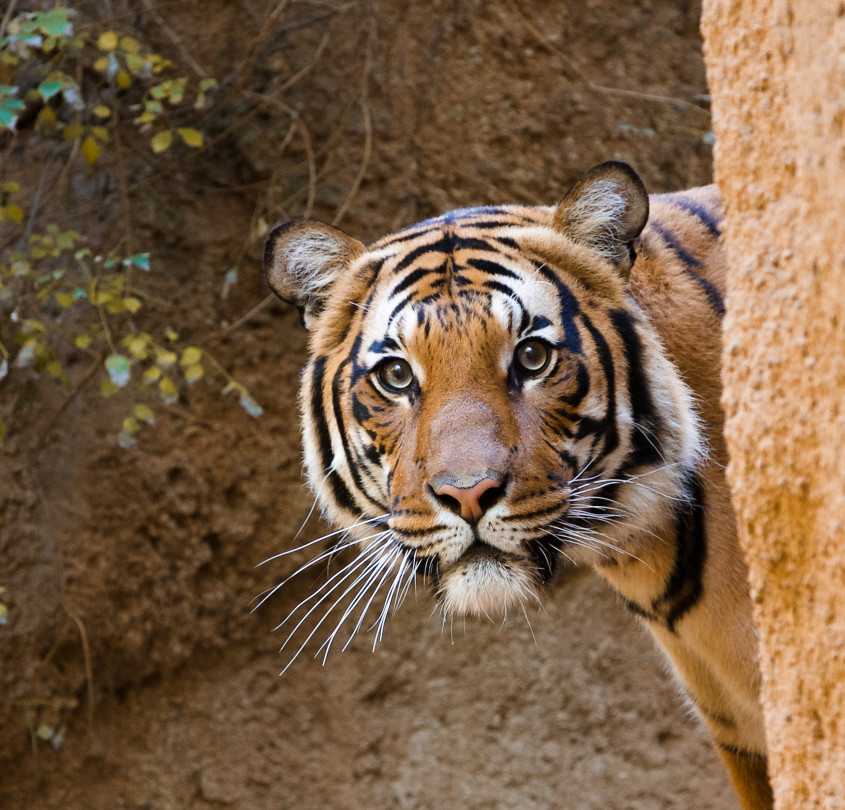The tiger is the largest living cat species. It is most recognisable for its dark vertical stripes on orange-brown fur with a lighter underside. It is a predator, preying on deer and wild boar.
It is territorial and generally a solitary but social predator, requiring large areas of habitat, which support its requirements for prey and rearing of its offspring.
Tiger cubs stay with their mother for about two years, before they become independent and leave their mother’s home range to establish their own.
Today, the tiger’s range is fragmented, stretching from Siberian temperate forests to subtropical and tropical forests on the Indian subcontinent and Sumatra.
India currently hosts the largest tiger population. Major reasons for population decline are habitat destruction, habitat fragmentation and poaching.
The tiger is the national animal of India, Bangladesh, Malaysia and South Korea.

Tiger Facts
Tigers are the biggest cats in the world.
There are 5 subspecies of tiger.
There are only about 7400 tigers are left in the wild
Adult tigers weigh up to 363kg.
Tigers can move at speeds of 65km/hour.
A tiger’s tail helps it balance while its running.
The first tigers appeared 2 million years ago.
A wild tiger has an average lifespan of 10-15 years.
A captive tiger can live up to 20 years.
A tiger’s roar can be heard from 3 kilometres away.
Tigers prey on deer, buffalo, antelopes, and other larger mammals.
Tigers hunt at night.
Wild tigers are carnivores.
Only one in every 20 hunts ends in a kill.
A group of tigers is called a streak or an ambush.
Siberian tiger is the biggest of all subspecies.
Sumatran tigers are the smallest among all subspecies.
The Bengal tiger is the best-known of all tigers.
Shere Khan in the movie The Jungle Book is a Bengal tiger.
Tigers have over 100 stripes.
No two tigers have the same pattern of stripes.
These stripes provide camouflage in the wild.
Their tails help tigers balance their body.
Tigers can leap forward for at least 8 metres in a single jump.
They can also jump up to 5 metres vertically.
The tiger is the national animal of both India and Bangladesh.
A Siberian tiger has almost 20,000 hairs per square inch.
A tiger’s claws can grow up to 4.7 inches long.
A tiger can eat nearly 1/5 of its body weight in one meal.
The Siberian tiger stripes are brown.
There are almost as many tigers living in zoos and wildlife parks as there are in the wild.
In the US, the number of tigers that are kept as pets is larger than the number in the wild.
Tigers are solitary animals.
Tigers only meet during mating season.
Tigers have large paws and sharp, retractable claws.
Tigers are excellent swimmers.
They can easily swim 4 miles.
Tigers can see 6 times better than humans at night.
A print of a tiger paw is called a pug mark.
A tiger spends about 18 hours a day sleeping.
Tigers also have striped skin.
Over the past 100 years, over 95% of the tiger population has disappeared.
Tigers cannot purr.
Tigers are territorial animals, Depending on the subspecies that can be 10-30 square miles.
In some cases it can be up to 120 square miles.
White tigers are special kind of tigers that appears rarely in the wild.
Black tigers exist as well, though none live in captivity.
Female tiger is called a tigress.
